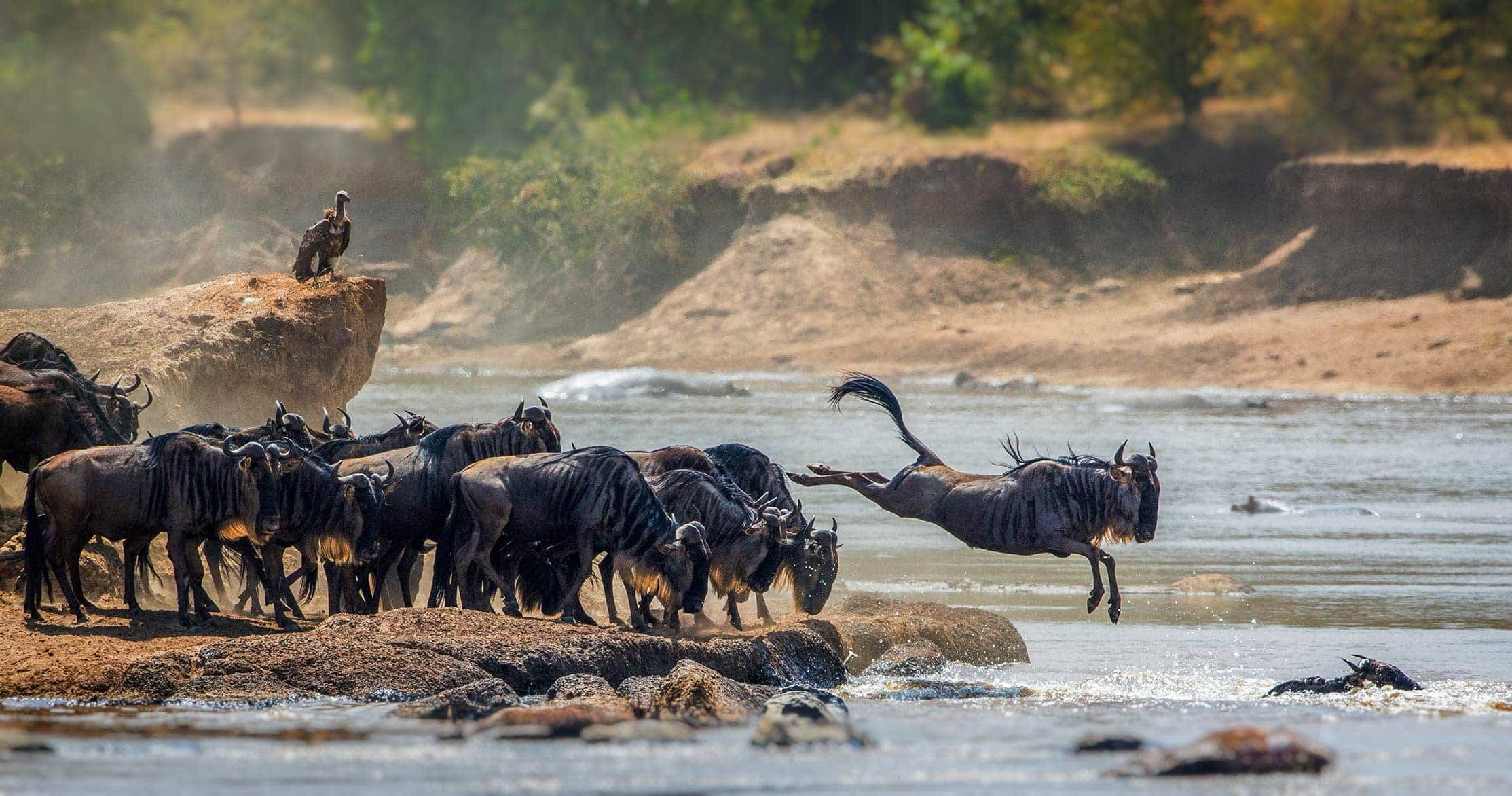Introduction
The Great Wildebeest Migration; Whereas the term migration has severally been associated with human beings, it is essential to acknowledge that it is a process that also occurs among animals. In zoology terms, migration refers to the seasonal movement of animals from one region to another. Moreover, the main reason for animal migration is the search for pasture and water.
Among the animals famous for their migration patterns are the wildebeests (gnus). These creatures are divided into two species, namely, the black wildebeests and the blue wildebeests. The migration of the wildebeests is not an ordinary kind. It is termed the great migration and is described as the most significant herd movement of animals on the planet. Interestingly, this migration involves 1000 animals per square kilometre, with the wildebeests totalling 1.2 million and the other animals (companions) such as zebras and gazelles totalling about 300000. Did you know that this exodus can even be viewed from space? Many more astonishing facts about this migration will be revealed as we go on.
A summary of the wildebeest’s profile

To begin with, wildebeests are antelopes that belong to the genus Connochaetes and are native to Eastern and Southern Africa. These animals belong to the Bovidae family, which comprises other animals such as cattle, sheep and goats. Wildebeests are mammals and thus feed their young ones on milk their mammary glands produce. More importantly, Wildebeest is an Afrikaans name from South Africa that means “wild beast”.
Concerning physical appearance, these animals look like thin muscular cows with large, sloping backs, stripped bodies, short, broad heads, manes, bushy beards and curved horns. In line with all the previous, wildebeests feed on grass and eat succulent plants and karoo bushes. It has also been documented that they start grazing shortly after sunrise, take a break around midday, and continue feeding until the sun sets. In addition, wildebeests take water almost every day and sleep for only four and a half hours daily.
It is also worth noting that wildebeests are intelligent animals. This is portrayed by their executing specific tactics to protect them from being attacked. For example, while some nap, others watch for potential predators. Moreover, these animals are always on the move and only stay in one place for a short time.
Life expectancy
Wildebeests have a life expectancy of 20 years in the wild. The young ones (calves) are usually born in February and March every year, at the beginning of the rainy season. The number of calves born annually totals up to 500000. Surprisingly, these calves learn how to walk within the first minutes of birth, and in a few days, they can keep up with the herd while moving alongside their mothers.
Where do we find wildebeests?
As earlier mentioned, wildebeests are only found in Eastern and Southern Africa, from Kenya to Namibia. They prefer to live in the savannahs and the plains but can also be found in dense bushes and open woodland flood plains. These creatures have their largest populations in the Serengeti in Tanzania and Kenya. This is major because the plains therein have pastures with the highest protein and calcium content.
Some habits are unique to only gnu herds, such as being active both night and day and constantly searching for food and water. They also communicate through sight, smell and making loud noises. That said, during the mating season, males do not sleep or eat in the presence of sexually active females.
The Great wildebeest migration
Holding the status of being one of the most desired experiences for wildlife fanatics, the great migration is defined as the continuous circular movement of over a million animals across the Serengeti-Mara ecosystem. This constant movement involves wildebeests and other animals known as companions, such as zebras and gazelles. Together, these animals follow an ancient route searching for nutritious pasture and water.
The movement of these creatures
During this journey, each wildebeest can cover about 800 to 1000 kilometres along the migration routes with the guidance of its survival instinct. Interestingly, the wildebeests can find directions during the migration by following the rains and growing new grass. Scientists contend that wildebeests can detect rain from more than 50 kilometres away. Other people think these creatures respond to thunderstorms and lightning, as seen from a distance.
Despite specific scenarios that occur along the way, such as the dropping of calves or the attempts to cross rivers to avoid predators, migration still occurs throughout the year.
Survival for the fittest
In the course of the Great Wildebeest Migration, also referred to as “the greatest show on earth”, it is not all peaceful and safe for the migrating animals as predators such as crocodiles, lions, leopards, and cheetahs ensure that only the fittest survive. They eat thousands, especially the young calves and the weak, slow ones. Besides that challenge, some animals encounter broken legs as they climb the steep river slopes while the tired ones drown in the water. Two notable facts about wildebeests concerning their movement include their ability to swim and the fact that they can run at a speed of 80km/hr – which is fast.
Furthermore, the thousands of migrating animals split into subgroups called mega herds to ensure enough food for the entire herd. The smaller sub-herds follow a slightly different path while moving in the same direction as the rest of the herd.
The Course of the Great Wildebeest Migration
The migration commences after the completion of calving in the Southern part of Tanzania’s Serengeti, located near the Ngorongoro Conservation Area. The animals move from there and pass through Serengeti, going up and around clockwise towards the Masai Mara in Kenya. After that, they journey back to their original destination towards the end of the year. Along the way, as predators eat thousands of animals, thousands more are born, replacing the dead and maintaining the circle of life. This trend is the reason why wildebeests are less likely to be extinct.
January, February and March
Every year, around January, the migration will most likely finish a southward trek, moving into the Ngorongoro Conservation Area. They move from the Eastern edge of the Serengeti. The plains in this area have plenty of nutritious grass. This provides a suitable condition for the animals to raise their newborn calves. Although there is no actual beginning or end of the course, it seems appropriate to refer to the wildebeests’ birthing season as the start of the Great Migration.
Towards the end of January or early February, the herds travel to the lower Northern slopes of the Ngorongoro Crater highlands and around Olduvai Gorge to occupy the short grass plains. Within two to three weeks, about 400,000 calves are born. Unfortunately, their large numbers attract many predators who hunt and feed on many of them.
April and May
After the calving season, the wildebeests start travelling northwest towards the fresher grass of the Central Serengeti, along with thousands of zebras and some antelopes. This movement takes place in April.
By the start of May, one can see columns of wildebeests covering several kilometres as they cluster by the Moro Kopjes. Towards the end of the month, the mating season begins. Then, migration continues with the animals grazing as they embark on their journey.
The herds then gather momentum and move in the Serengeti’s Western Corridor. From this point, the animals converge along the pools and channels of the Grumeti River in preparation for the great crossings.
June and July
The dry season begins in June. During that period, tourists can see large groups of wildebeests on the Southern banks of the Grumeti River and in the Western Serengeti.
Between June and July, the migrants proceed north along the park’s western edge towards the Mara River in the North of Serengeti. The crossings, one of Earth’s most exciting wildlife events, begin in July. As the herds swim across, crocodiles and other predators may eat some of them, and the tired ones may drown. However, the strong ones can cross successfully to Masai Mara.
August, September and October
By August, the herds appear throughout the Masai Mara’s northern region, especially in the Northern Serengeti, after experiencing severe challenges during the crossings.
November and December
After the East African short rains, the wildebeests move into the Eastern limits of the Serengeti past Namiri Plains between late October and early November. These plains are famous for cheetah sightings. By December, the wildebeests appear throughout the Eastern and Southern parts.
As the new year begins, the grasses in the Southern part of Serengeti start to grow due to the rains. This attracts the wildebeests and their migration companions. From this point, the cycle continues while the calving season also commences.
Conclusion
There is no doubt that following the Great Wildebeest migration from the beginning to the end is one of the most exhilarating, educational and fulfilling experiences anyone could ever have. Make your safari booking with us today and make your travel dreams a reality!
